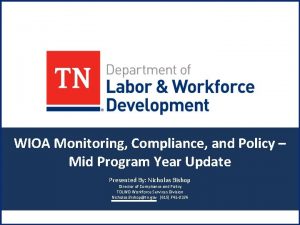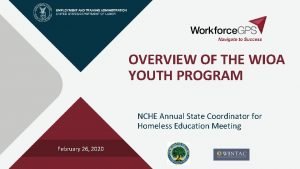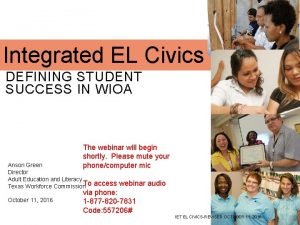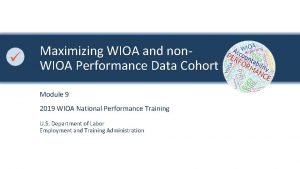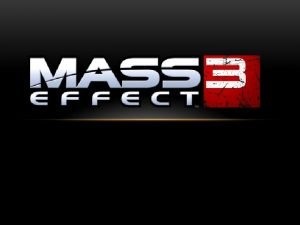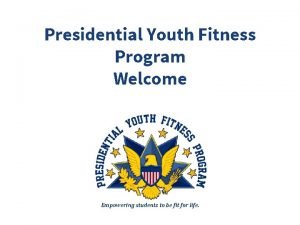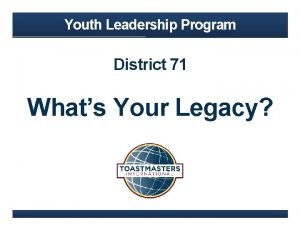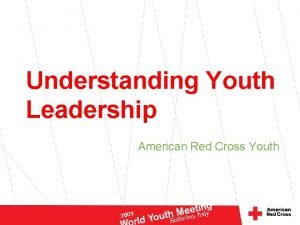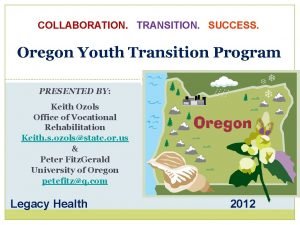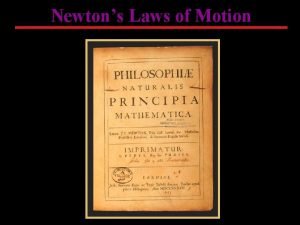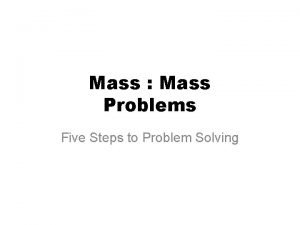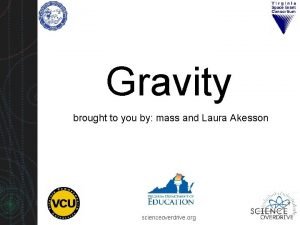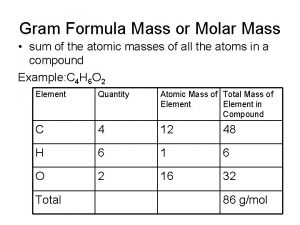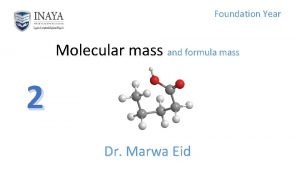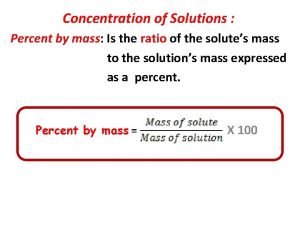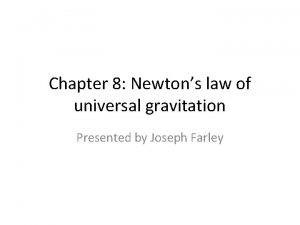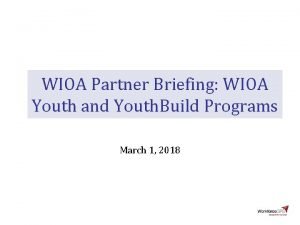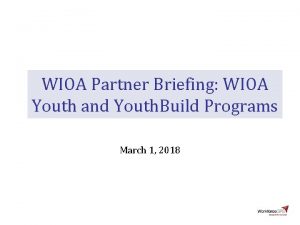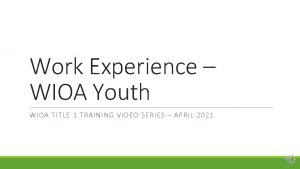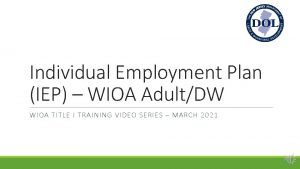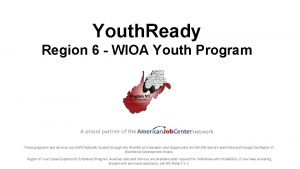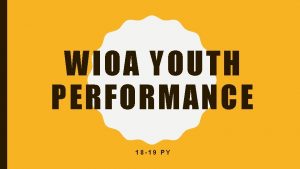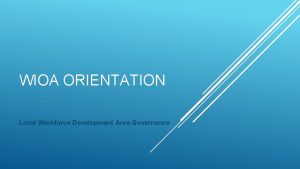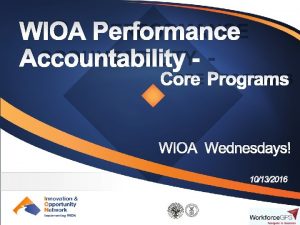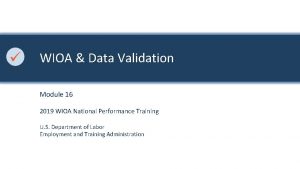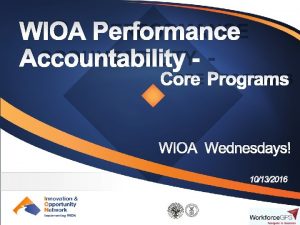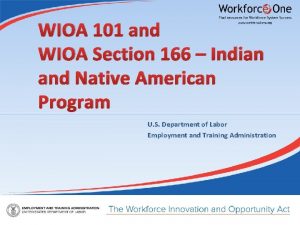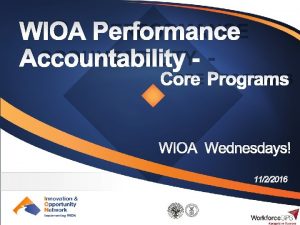WIOA Title I YOUTH PROGRAM https www mass

































- Slides: 33

WIOA Title I YOUTH PROGRAM https: //www. mass. gov/masshire-careercenters January 12, 2021

Today’s webinar will be recorded. • Please use the chat box to introduce yourself. • You can listen through speakers or use the dial-in option listed with the webinar link. • You can use the chat box or “raise hand” feature to ask a question. • Please remember to mute your computers and phones to minimize background noise. 2

TOPICS • IMPORTANCE OF WIOA • ELIGIBILITY CRITERIA FOR IN-SCHOOL YOUTH AND OUT-OF-SCHOOL YOUTH • WIOA TITLE I YOUTH ELIGIBILITY POLICY 100 DCS 19. 101. 4 • SOURCE DOCUMENTATION • 14 PROGRAM ELEMENTS • INDIVIDUAL SERVICE STRATEGY (ISS) AND CAREER PATHWAYS • YOUTH ISS IN MOSES • LEVERAGING PARTNER PROGRAMS 3

Importance of the Workforce Innovation and Opportunity Act (WIOA) • WIOA increases access to opportunities for employment, education, training, and support services to individuals, particularly those with barriers to succeed in the labor force. • WIOA provides funding for local areas to offer programs for in-school and out-of-school youth that provide a pathway to a GED, Hi. SET, high school diploma, higher education, industry-recognized training, and a career. 4

OUT OF SCHOOL YOUTH ELIGIBILITY • • US Citizenship/ Work Eligible and Selective Service Compliance AND Not Attending School 16 - 24 years at the time of enrollment AND, One or more of the following: 1. School dropout 2. Within the age of compulsory school* attendance, but has not attended school for at least the most recent complete school year calendar quarter 3. HS Grad/Hi. SET who is low-income and basic skills deficient or an English language learner 4. 5. 6. 7. 8. 9. An offender Homeless individual, a homeless child or youth, or a runaway In foster care or has aged out of the foster care system Pregnant or parenting An individual with a disability Low-income individual who requires additional assistance to enter or complete an educational program or to secure or hold employment * Compulsory school age in Massachusetts in between the ages of 6 -16. 5

When is low-income not an eligibility criteria for OSY? • OSY are not required to be low-income if they are: a US citizen/ work eligible, not attending school, 16 - 24 years old and meet one or more of the following criteria: o School dropout o Within the age of compulsory school attendance, but has not attended school for at least the most recent complete school year calendar quarter o An offender o Homeless individual, a homeless child or youth, or a runaway o In foster care or has aged out of the foster care system o Pregnant or parenting o An individual with a disability Examples: 1. 2. 3. 4. A high school dropout. A high school graduate that has a disability. A HISET recipient that is an offender. A Hi. SET recipient that is a pregnant or a parent. 6

When is low-income an eligibility criteria for OSY? • OSY are required to be low-income if they are: a US citizen/ work eligible, not attending school, 16 - 24 years old meets one of the following criteria: o HS Grad/Hi. SET and basic skills deficient or an English language learner o Individual who requires additional assistance to enter or complete an educational program or to secure or hold employment Examples: 1. A high school graduate that is basic skills deficient and does not have any of the other 7 OSY barriers. 2. A Hi. SET recipient that is an English language learner and does not have any of the other 7 OSY barriers. 3. A high school graduate or a Hi. SET recipient that is not basic skills deficient or an English language learner, and does not have any of the other 7 OSY barriers but meets the locally defined definition of a youth requiring additional assistance. 7

In School Youth Eligibility • • • US Citizenship/Work Eligible and Selective Service Compliance AND In School AND 14 – 21 years old Low Income Attending School One or more of the following: 1. 2. 3. 4. 5. 6. 7. 8. Basic skills deficient English language learner An offender Homeless individual, a homeless child or youth, or a runaway In foster care or has aged out of the foster care system Pregnant or parenting Individual with a Disability Requires additional assistance to enter or complete an educational program or to secure or hold employment • (not more than 5% allowed using this item) 8

What is Low Income for WIOA? • A WIOA youth participant will be considered Low Income if any of the following are true: o They are receiving public assistance (TAFDC, EAEDC, SNAP, SSI) o Their family income is at or below 70% of the Lower Living Standard (LLS) • (or below Poverty Line for family of one (1)) o They reside in a High Poverty Area o They have any of the following barriers: • Homeless/Runaway (as defined in Mc. Kinney Act) • Foster Care o They are in school and on a free or reduced lunch program 9

Low-Income status for youth can also be determined by the following: • Free and Reduced Price Lunch – Richard B. Russell National School Lunch Act Ø ISY Only Ø ISY that attend a designated low-income school do not automatically qualify as low-income Ø (Community Eligibility Provision) • High Poverty Area Ø ISY and OSY Ø Poverty rate of 25 percent – where at least 25 percent of the residents are economically disadvantaged. * New Instructions for Determining if an Individual Lives in a High-Poverty Area Based on Their Street Address. Mass. Workforce Resources: WIOA Title I Youth Program | Mass. gov 10

Low Income Exception (5% Window Eligibility) Five percent of WIOA youth participants, who would ordinarily be required to be lowincome for eligibility, and who meet all other eligibility requirements, may be non low income. The 5% calculation is based on the percent of youth newly enrolled in the fiscal year and served by the program in the local area’s WIOA youth program 11

WIOA TITLE I YOUTH ELIGIBILITY POLICY 100 DCS 19. 101. 4 • Updates: • Clarification to the Non- Low-Income Exception • Additional Updates to Attachment B – Eligibility Source Documentation – Added clarifying language under Eligibility Criteria / Sources of Documentation: This document listing may not be exhaustive. Should you encounter a document that is not listed here, please contact your MDCS Field Management and Oversight representative for assistance in discerning the document’s validity for the purpose of WIOA Title I eligibility. – Added Certificate of Attainment as acceptable source documentation for OSY – Added Letter from Commonwealth of Massachusetts EOHHS Agency as verification of Birth Date/Age – Added use of SAVE verification along with Government issued ID for verification of Work Authorization – Changed Cash Public Assistance criteria to Income Based Public Assistance to align with the definition of low-income as defined in WIOA sec. 3 (36) • Update to Attachment F – Document Inspection Form – Instructions for intended use of the form. 12

Source Documentation • Documentation is necessary to support WIOA Title I Youth Eligibility • Local Areas must verify and confirm that youth are eligible to participate in WIOA youth services through an examination of documents. • Documentation may be stored electronically, however documentation must be available to program, fiscal monitors, and auditors for monitoring purposes. • Local Areas must retain records for a period of at least three (3) years after the submittal of the final closeout expenditure report for that funding period. • Acceptable forms of source documentation can be found in Mass. Workforce Issuance 100 DCS 19. 101. 3 : WIOA Title I Youth Eligibility Policy 13

WIOA ELIGIBILITY DOCUMENTATION IN A VIRTUAL ENVIRONMENT - 100 DCS 18. 111 Policy Highlights Verifying Eligibility Documentation via Live Stream • • Allows verification of eligibility documentation through livestream (video sharing) such as Zoom, Web. EX, or Adobe Connects or other virtual media platform. A printout or an electronic copy of a screenshot containing the eligibility document verified must be included in the customer’s file Updated to allow the use of electronic signatures on eligibility documentation. Electronic Signatures • Participants must still sign documents when required. • Fillable forms for the use of electronic signatures is allowed • Staff may have the participant email agreement to the content of the required form. • The email must be kept in the participant file. Documenting MOSES • Staff must document the “Notes” section in MOSES when eligibility documentation was viewed via live stream and that either a printout or screen shot of the eligibility document is included in the customer’s file. 14

Examples of Acceptable Source Documentation Youth is out of school and homeless (Example include and are not limited to the following: ) þ Age - Birth Certificate/US Passport þ US Citizenship/Work Authorization – Birth Certificate/ Unexpired Alien Registration Card with Authorization to Work þ Selective Service Compliant – Selective Service online Verification þ Out of school Verification - HSD/ Hi. SET Certificate/ HS Transcript þ Homeless – Letter from shelter/ Applicant Statement with Corroborating Witness Youth is in school and an offender (Example include and are not limited to the following: ) þ Age – Federal, State or local government identification card that includes date of birth þ US Citizenship/Work Authorization – Certificate of Naturalization þ Selective Service Compliant – Stamped post office receipt of registration þ In School Youth Verification – Report Card/ Letter from school on school letter head þ Low-Income – School lunch verification form with youth’s name/ Print out from Poverty Threshold Census Tract database þ Offender – Court documentation/ Written statement from State/Local agency 15

WIOA Youth Program Provisions Out–of–School Youth • Local areas must spend a minimum of 75 percent of program funds on OSY. Paid and Unpaid Work Experiences for ISY and OSY • At least 20% of local Youth formula funds must be used for work experiences Work Experience: Summer and other employment opportunities throughout the school year Pre-apprenticeship programs Internships and job-shadowing On-the-Job training opportunities • Allowable Work Experience Expenditures Include: -Staff time working with employers to ensure a successful work experience - Staff time spent evaluating the work experience - Participant work experience orientation sessions - Classroom training or the required academic component directly related to the work experience For a complete listing of allowable work experience expenditures visit: Mass. Workforce Issuance 100 DCS 19. 106: WIOA Title I Youth Work Experience Expenditure Requirement 16

WIOA Program Elements All youth must have access to the 14 WIOA program service elements Program Element Description MOSES Activity and/or Service Tutoring, Study Skills Training, Instruction Development of educational achievement skills that leads to the completion of the requirements for a secondary or post secondary school diploma/credential. Activity Categories: Educational Training, Hi. SET/ASE, Dropout Prevention/Tutoring, Basic ABE, Basic ESL/ESOL, Adult Educ/Literacy w/Training Alternative Secondary School Alternative secondary school services, or drop out recovery services. Activity Categories: Alternative School Work Experience Summer Employment Pre apprenticeship programs Internships/Job Shadowing OJT Opportunities Work experiences which include summer employment, year round employment, preapprenticeship, internships/Job-Shadow and In/On-the-job training opportunities. Activity Categories: Work Exp/Summer Youth Academic/Occ Learning – Summer Work Experience, Pre Apprenticeship In/On the Job Training Workplace Training/Coop Ed Pgms Internship, Job Shadowing 17

WIOA Program Elements Program Element Description MOSES Activity and/or Service Education concurrently w/Workforce Prep Integrated education and training that occur concurrently and contextually with workforce preparation. Activity Categories: Education w/Workforce Prep Leadership Development Opportunities that encourage responsibility, confidence, employability, self-determination and other positive social behaviors. Activity Categories: Community Service Leadership Development Supportive Services that enable youth to participate in Service Categories: program activities such as assistance with Supportive Services – except Needs book, fees, school supplies, Related Payment transportation, and legal aid services. Adult Mentoring (12 months min) Participants receive adult mentoring for a period of not less than 12 months that connects to the youth’s goals. Activity Categories: Mentoring 18

F e b r u a r y 1 , 2 0 1 8 WIOA Program Elements Program Element Description MOSES Activity and/or Service Comprehensive Guidance & Counseling Individualized counseling which includes drug and alcohol abuse, and mental health counseling, and referral to partner programs. Activity Categories: Comprehensive Guidance and Counseling Financial Literacy Education Support the ability of participants to create budgets, learn how to manage spending, credit, and debt. Activity Categories: Financial Literacy Education Service Categories: Counseling/ Financial Counseling Entrepreneurial Skills Training Entrepreneurial skills training provides the basics of starting and operating a small business. Activity Categories: Entrepreneurial Skills Training Labor Market Services Participants receive access to career counseling, career exploration, career awareness, and the use of labor market tools. Service Categories: Job Search Automated Labor Exch Job Order Search Labor Market Info Resource Room 19

WIOA Program Elements Program Element Description MOSES Activity and/or Service Follow-up Services (12 months) Follow-up services are provided for 12 months Service Categories: unless the participants declines to receive follow- Follow-Up (Title I) up services or cannot be located or contacted. Occupational Skills Training An organized program of study that provides specific vocational skills that lead to proficiency in performing actual tasks and technical functions required by certain occupational fields. Activity Categories: Occupational Skills Training Skill Upgrade and Retraining Transition to Post Secondary Education Participants receive access to job exploration counseling, work based learning experiences, instruction in self-advocacy, work readiness training. Activity Categories: Post Sec/Training Transition Activities Service Categories: Counseling Trans to Post Sec Ed/Training 20

Individual Service Strategy Plan An Individual Service Strategy (ISS) plan must be developed for each youth participant and must: • Include career planning and the results of objective assessments • Include education and employment goals • Include achievement objectives and services • Directly link to one or more performance indicators • Identify an appropriate career pathway WIOA Youth Individual Service Strategy: 100 DCS 19. 107 • ISS Template Attachment 21

Assessments are important in determining the appropriate services for youth. The ISS is based on an objective assessments that includes a review of participant: • academic skill levels • service needs • Strengths and assets Basic Skills Deficient – a youth that is at or below the 8 th grade level in English reading, writing, or computing skills as evidenced by a generally accepted standardized test. Testing tools for measuring educational functioning levels (EFLs) must be on the National Reporting Systems (NRS) federally approved list of assessments. (CASAS TABE, MAPT, etc. ) 22

Assessments Local areas may use formalized testing tools that are valid and reliable. Testing tools should also be appropriate, fair, and cost effective and easy to administer and interpret results. Assessment Tool Examples: – MASSCIS – Work Keys Placement Quiz – My Next Move – Career One-Stop - Get. My. Future – My. Skills My. Future Work. Keys assessment crosswalk tools | Mass. gov 23

ISS Development Consider Dedicate enough time to complete the ISS with the youth. Allow time to brainstorm and develop their “road map” and how they plan on accomplishing their goals. Introduce the concept of and encourage the youth to develop SMART goals (specific, measurable, achievable, relevant, and time-bound). Include Addresses key goal areas in education, training, employment and personal development Includes short and long-term goals Ties the goals to the 14 WIOA Youth Program elements/service areas Includes objectives and actions steps Includes needed referrals for services and support services Includes timelines with start, end and review dates Encourage the youth to lead and take ownership of the ISS process Celebrate successes and create learning opportunities from setbacks Includes appropriate individuals involved in ISS implementation Addresses potential barriers Includes youth-staff agreements and Includes 1 st and 2 nd review dates and signatures of the youth and staff responsible for development of the ISS 24

Youth ISS in MOSES 25

Enrollment • In order to participate in the WIOA youth program the following must occur: – Eligibility determination – Objective assessment – Development of the ISS – Participation in any of the 14 program elements 26

WIOA Career Pathway CAREER PATHWAY—The term ‘‘career pathway’’ means a combination of rigorous and high-quality education, training, and other support services that— • Aligns with the skill needs of industries; • Prepares individuals to be successful in education options; • Includes counseling to support education and career goals; • Includes contextualized learning within an occupational cluster; • Organizes education, training, and other services that accelerates education and career advancement; • Enables the attainment of a secondary and at least one postsecondary credential; • Supports entrance or advancement within a specific occupation or occupation cluster. 27

Career Pathway Concept using a customer centered design approach Training Education Support Services Putting the individuals needs at the center of service delivery. 28

Identify Appropriate Career Pathways What must you do? 1. Provide youth with information that allows for exploration of career options along with the education, training, and or skills needed to be successful in those careers. 2. Provide information on career options to assist youth in setting career goals and to make informed decisions about appropriate career pathways. 3. Note career goals for younger youth must be age appropriate and may identify a career interest that can be developed into a career goal. 4. Recognize that goals may change as youth get older and interests broaden this must be reflected in a revision of the ISS and documented in case notes. 5. Work in conjunction with the youth to determine interests, aptitudes, skills, and values that are important to the youth in identifying an appropriate career pathway. 29

Leveraging Partner Programs Case management is important for service alignment and to avoid duplication ! 30

Youth Service Delivery Framework 31

Thank You Questions? ? 32

Resources • WIOA Youth Program Resources – Workforce GPS o https: //youth. workforcegps. org/resources/2017/03/22/09/55/WIOA-Youth. Program-Resources-Page • Massachusetts Career Information System o http: //www. mass. gov/massworkforce/resources/masscis/ • Workforce Innovation and Opportunity Act o https: //www. congress. gov/bill/113 th-congress/house-bill/803/text • Workforce Innovation and Opportunity Act: Department of Labor Only – Final Rule o https: //www. gpo. gov/fdsys/pkg/FR-2016 -08 -19/pdf/2016 -15975. pdf • Department of Labor TEGL 10 -16, Change 1 Performance Accountability o https: //wdr. doleta. gov/directives/corr_doc. cfm? DOCN=8226 • Department of Career Services Youth Program Resource Page o http: //www. mass. gov/massworkforce/programs/youth/ 33
 Wioa youth program elements
Wioa youth program elements Wioa
Wioa Wioa
Wioa Wioa
Wioa Wioa optimized system
Wioa optimized system Wioa maryland
Wioa maryland Writing and completing reports and proposals
Writing and completing reports and proposals Title title
Title title Mass effect title
Mass effect title Presidential youth empowerment
Presidential youth empowerment Toastmasters youth leadership program certificate
Toastmasters youth leadership program certificate Red cross youth leadership program
Red cross youth leadership program Oregon youth transition program
Oregon youth transition program How to solve stoichiometric calculations
How to solve stoichiometric calculations Isotopes
Isotopes Relative atomic mass of beryllium
Relative atomic mass of beryllium How to calculate percentage by mass
How to calculate percentage by mass Inertial mass vs gravitational mass
Inertial mass vs gravitational mass Mole ratio
Mole ratio How to convert moles to grams
How to convert moles to grams Molar mass def
Molar mass def How to convert to molar mass
How to convert to molar mass Unit for molar mass
Unit for molar mass Mass/mass problems
Mass/mass problems Differentiate between atomic number and mass number
Differentiate between atomic number and mass number Gravitational mass vs inertial mass
Gravitational mass vs inertial mass Molar mass table
Molar mass table Cl- molar mass
Cl- molar mass How to find the atomicity of a molecule
How to find the atomicity of a molecule Formula mass vs molar mass
Formula mass vs molar mass How to find percent concentration
How to find percent concentration Inertial mass vs gravitational mass
Inertial mass vs gravitational mass Co2 relative molecular mass
Co2 relative molecular mass O
O

